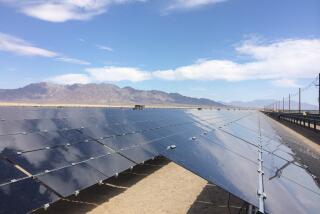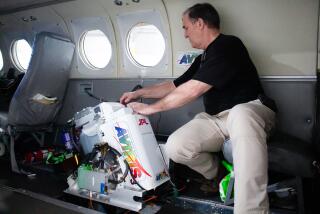It’s a tidy answer to global warming
Here’s a simple solution to global warming: vacuum carbon dioxide out of the air.
Klaus Lackner, a physicist at Columbia University, said placing enough carbon filters around the planet could reel the world’s atmosphere back toward the 18th century, like a climatic time machine.
After a decade of work, his shower-sized prototype whirs away inside a Tucson warehouse, each day capturing about 10 pounds of the heat-trapping greenhouse gas as air wafts through it.
Only a few billion tons to go.
In the battle against global warming, technology has long been seen as the ultimate savior, but Lackner’s machine is a clunky reminder of how distant that dream is.
He estimates that sucking up the current stream of emissions would require about 67 million boxcar-sized filters at a cost of trillions of dollars a year.
The orchards of filters would have to be powered by complexes of new nuclear plants, dams, solar farms or other clean-energy sources to avoid adding more pollution to the atmosphere.
Despite the scope of the proposal, the allure of high technology is irresistible for modern humans. Salvation has arrived again and again over the last century: the automobile, the jet, the Internet, the iPod.
That dream has pushed scattered groups of scientists to work on massive schemes to reengineer the planet.
One idea is to block sunlight, either by constructing artificial volcanoes to blast sulfur particles into the atmosphere or by launching millions of tiny satellites into space and arranging them into a giant mirror.
Another concept is sprinkling iron over the oceans to nurture plankton colonies that would absorb carbon dioxide from the air and transfer it to the depths.
But while the science of dialing back the planet’s thermostat is straightforward, the execution is fabulously expensive, complex and grandiose on a scale that boggles the mind.
“Nobody doubts it is possible to take CO2 out of the air,” said David Keith, a professor of engineering and economics at the University of Calgary in Canada and one of several scientists around the world working on the problem. “The issue is, ‘What does it cost?’ ”
Some policy experts argue that blind faith in technology is a harmful distraction from the hard sacrifices needed to control global warming.
“The temptation is to say, ‘Let’s get John Wayne on horseback or Bill Gates . . . and solve this problem,’ ” said Dale Jamieson, director of environmental studies at New York University.
But some scientists say that the potential of such ideas cannot be ignored given the world’s political paralysis on controlling emissions and its myopic addiction to cheap and dirty coal.
“There are not that many alternatives,” Lackner said.
The attraction of a technological silver bullet lies in the failure of the world to solve global warming through the obvious solution: reducing emissions.
The 1997 Kyoto accords were supposed to bring the world together to address the problem, but the two biggest polluters, the United States and China, have refused to cap their emissions, and Europe is failing to meet even its modest targets.
Worldwide annual emissions of carbon dioxide -- the main culprit in global warming -- have climbed 28% over the last decade, according to the U.S. Department of Energy. The rise has been largely driven by industrializing countries, such as China and India, which argue that they have the right to exploit their coal reserves to catch up with the West.
It is clear that cheap energy is a drug that civilization will not give up. But big technological solutions could allow society to keep its drug.
Among the options, carbon filtering is the most direct and best understood. If industrialization is a process of transferring carbon stored in the earth to the atmosphere, filtering seeks to put it back.
The technology is decades old. Bottled oxygen used in hospitals started out as plain air before nitrogen, carbon dioxide and other gases were filtered out. Space capsules and submarines extract carbon dioxide to maintain breathable air for crew members.
The process for removing atmospheric carbon involves putting one compound, usually a hydroxide, in contact with the air, setting off a reaction that grabs CO2 and incorporates its carbon atoms into a carbonate compound.
Then, in a reaction that requires a large input of heat, the carbonate compound is broken apart, reconstituting and trapping the carbon dioxide.
Researchers propose pumping the captured CO2 into the ground, a practice already used to increase the pressure in oil wells. Geologists say there is room in subterranean rock formations to lock it away forever.
The beauty of carbon capture is that it scrubs the planet without intruding on it, unlike artificial volcanoes and sun reflectors, which could cause enormous planetary damage in the form of acid rain or giant shadows that stunt crops.
The filters could be placed anywhere in the world, since carbon dioxide disperses throughout the atmosphere.
For all its appeal, the process is hideously inefficient. Carbon dioxide makes up less than 0.04% of the atmosphere, and removing climate-changing quantities of it requires filtering massive amounts of air.
Lackner calculated that sucking up all 28 billion tons of CO2 released worldwide each year would require spreading out his machines over a land area the size of Arizona.
That seems like a reasonable sacrifice to save civilization, until you consider the expense.
Experts estimate that it would cost up to $200 a ton to filter and store carbon dioxide from the air. That means the yearly vacuuming bill could reach $5.6 trillion.
Even filtering the greenhouse gas from smokestacks, where it is hundreds of times more concentrated and thus much cheaper to capture, is still deemed too expensive for commercial use.
The enormous cost raises the question: Who would pay?
It is the same impasse that has stymied efforts toward a global agreement to reduce emissions. China argues that the West should foot the bill because it created the problem over the last two centuries. The United States says China must accept its share of responsibility as the world’s new top polluter.
The cost of the technology will surely fall over time, but without government action that is unlikely to happen soon enough to stave off the worst effects of climate change.
Without at least a 50% cut in emissions by mid-century, the United Nations’ Intergovernmental Panel on Climate Change predicts that the temperature rise will exceed 2 degrees, resulting in worsening drought, a dangerous sea level rise and widespread extinction of species.
Paul Crutzen, a Nobel Prize-winning atmospheric chemist at the Max Planck Institute for Chemistry in Mainz, Germany, said that the failure to cut emissions might force the world to reshape the environment through drastic use of technology.
The risks could be enormous, but the risks of failing to reduce emissions could be greater, he said.
Crutzen said that only out of a “sense of despair” had he come to favor the last-ditch option of spewing more than a million tons of sulfur a year into the air.
It’s a dirty proposition that, in some ways, is its own environmental crime. But it works, as shown by the 1991 Mt. Pinatubo eruption in the Philippines, which temporarily cooled the planet by almost 1 degree Fahrenheit. “It might be the last escape route from the problem,” he said.
The power to reengineer the planet raises another question: Who gets to control the thermostat? Despite the perception that climate change is a global problem, it is in reality a series of regional transformations that benefits some places and harms others.
Countries in the far northern latitudes have less incentive than tropical countries to counteract the warming. Russia has already laid claim to the North Pole in hopes that the arctic thaw will open access to new oil reserves. Canada is pondering the possibility of its vast expanse of tundra becoming a breadbasket.
With enough carbon filters, a single country or even several rich individuals would have the power to set the world’s temperature.
“No matter how you go about it, there will be a lot of politics,” Lackner said.
For now, his machine, a solitary prototype, continues to hum away in the Tucson warehouse. With no good place to store the carbon dioxide it traps, the gas is simply released back into the air.
---







